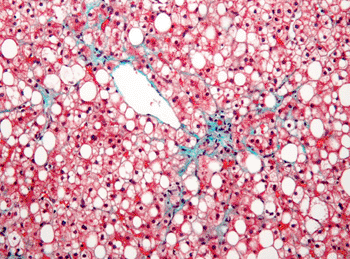Identified Genes Associated with Unhealthy Liver Function
By LabMedica International staff writers
Posted on 16 Oct 2013
Genes associated with unhealthy liver function have been identified in overweight patients with diabetes in a groundbreaking study.Posted on 16 Oct 2013
Nonalcoholic fatty liver disease (NAFLD) is the buildup of extra fat in liver cells, not caused by alcohol and it is one of the most common causes of chronic liver disease. Steatohepatitis (NASH) is liver inflammation and damage caused by a buildup of fat in the liver, not caused by alcohol.

Image: Micrograph of nonalcoholic fatty liver disease (Photo courtesy of Nephron).
Scientists at the Translational Genomics Research Institute (TGen; Phoenix, AZ, USA) carried out a genome-wide analysis to identify loci associated with total bilirubin levels, steatosis, and mild fibrosis in nonalcoholic fatty liver disease. They examined how genomic factors affect the development of nonalcoholic fatty liver disease. There were nearly 2,300 patients included in the study and all with extreme obesity enrolled in a bariatric surgery program.
The study identified evidence for association with markers in the neurocan gene (NCAN) on chromosome 19p12, and rs2501843 on chromosome 1. Johanna DiStefano, PhD, the Director of Translational Genomics Research Institute’s Diabetes, Cardiovascular and Metabolic Diseases Division, and the study’s principal investigator, said, “These genetic factors could help us identify patients who are most at risk of developing nonalcoholic forms of fatty-liver disease (NAFLD), and which patients may be more likely to progress to severe forms of NAFLD, such as steatohepatitis (NASH).”
Glenn S. Gerhard, MD, a co-investigator of the study and a faculty member of the Geisinger Obesity Institute (Danville, PA, USA) and the Administrative Director for the Institute for Personalized Medicine at Penn State Hershey Medical Center (Hershey, PA, USA) added, “Our results showed evidence for new genetic loci that may play a role in the biological mechanisms of NAFLD and NASH. We discovered genes that may help identify those patients most at risk for the types of liver disease so severe that they could require transplants." The study was presented at the 64th annual meeting of the American Association for the Study of Liver Diseases held November 1-5, 2013, in Washington DC (USA).
Related Links:
Translational Genomics Research Institute
Geisinger Obesity Institute
Penn State Hershey Medical Center













